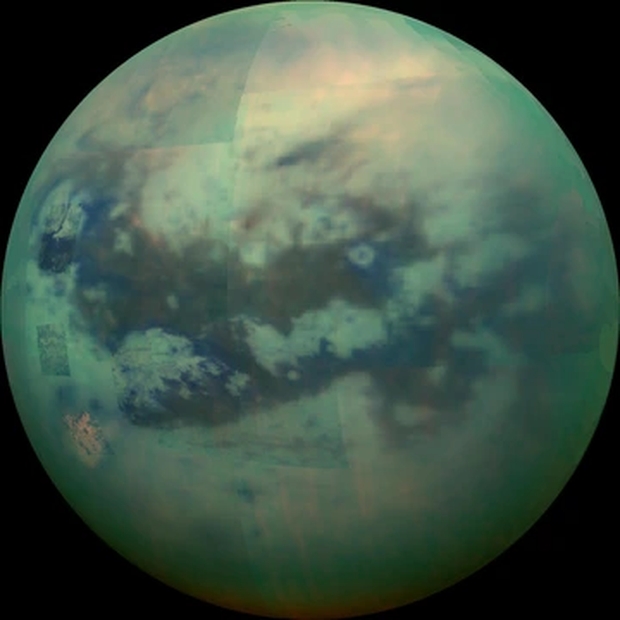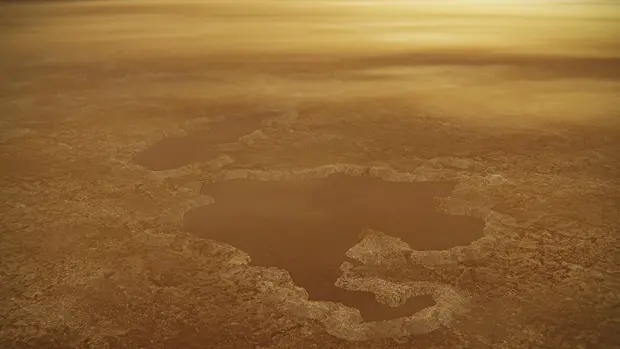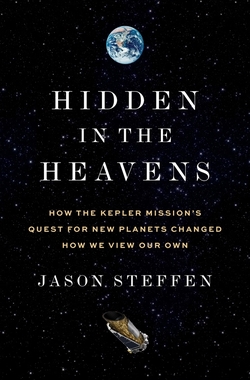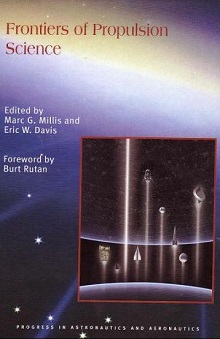When it comes to oceans beneath the surface of icy moons, Europa is the usual suspect. Indeed, Europa Clipper should have much to say about the moon’s inner ocean when it arrives in 2030. But Titan, often examined for the possibility of unusual astrobiology, has an internal ocean too, beneath tens of kilometers of ice crust. The ice protects the mix of water and ammonia thought to be below, but may prove to be an impenetrable barrier for organic materials from the surface that might enrich it.
I’ve recently written about abused terms in astrobiological jargon, and in regards to Titan, the term is ‘Earth-like,’ which trips me every time I run into it. True, this is a place where there is a substance (methane) that can appear in solid, liquid or gaseous form, and so we have rivers and lakes – even clouds – that are reminiscent of our planet. But on Earth the cycle is hydrological, while Titan’s methane mixing with ethane blows up the ‘Earth-like’ description. For methane to play this role, we need surface temperatures averaging −179 °C. Titan is a truly alien place.
In Titan we have both an internal ocean world and a cloudy moon with an atmosphere thick enough to keep day/night variations to less than 2 ℃ (although the 16 Earth day long ‘day’ also stabilizes things). It’s a fascinating mix. We’ve only just begun to probe the prospects of life inside this world, a prospect driven home by new work just published in the Planetary Science Journal. Its analysis of Titan’s ocean as a possible home to biology doesn’t come up completely short, but it offers little hope that anything more than scattered microbes might exist within it.

Image: This composite image shows an infrared view of Titan from NASA’s Cassini spacecraft, acquired during a high-altitude fly-by, 10,000 kilometers above the moon, on Nov. 13, 2015. The view features the parallel, dark, dune-filled regions named Fensal (to the north) and Aztlan (to the south). Credit: NASA/JPL/University of Arizona/University of Idaho.
The international team led by Antonin Affholder (University of Arizona) and Peter Higgins (Harvard University) looks at what makes Titan unique among icy moons, the high concentration of organic material. The idea here is to use bioenergetic modeling to look at Titan’s ocean. Perhaps as deep as 480 kilometers, the ocean can be modeled in terms of available chemicals and ambient conditions, factoring in energy sources (likely from chemical reactions) that could allow life to emerge. Ultimately, the models rely on what we know of the metabolism of Earth organisms, which is where we have to start.
It turns out that abundant organics – complex carbon-based molecules – may not be enough. Here’s Affholder on the matter:
“There has been this sense that because Titan has such abundant organics, there is no shortage of food sources that could sustain life. We point out that not all of these organic molecules may constitute food sources, the ocean is really big, and there’s limited exchange between the ocean and the surface, where all those organics are, so we argue for a more nuanced approach.”
Nuance is good, and one way to explore its particulars is through fermentation. The process, which demands organic molecules but does not require an oxidant, is at the core of the paper. Fermentation converts organic compounds into the energy needed to sustain life, and would seem to be suited for an anaerobic environment like Titan’s. With abiotic organic molecules abundant in Titan’s atmosphere and accumulating at the surface, a biosphere that can feed off this material in the ocean seems feasible. Glycine, the simplest of all known amino acids and an abundant constituent of matter in the early Solar System, serves as a useful proxy, as it is widely found in asteroids and comets and could sink through the icy shell, perhaps as a result of meteorite impacts.
The problem is that this supply source is likely meager. From the paper:
Sustained habitability… requires an ongoing delivery mechanism of organics to Titan’s ocean, through impacts transferring organic material from Titan’s surface or ongoing water–rock interactions from Titan’s core. The surface-to-ocean delivery rate of organics is likely too small to support a globally dense glycine-fermenting biosphere (<1 cell per kg water over the entire ocean). Thus, the prospects of detecting a biosphere at Titan would be limited if this hypothetical biosphere was based on glycine fermentation alone.

Image: This artist’s concept of a lake at the north pole of Saturn’s moon Titan illustrates raised rims and rampart-like features as seen by NASA’s Cassini spacecraft. Credit: NASA/JPL-Caltech.
More biomass may be available in local concentrations, perhaps at the interface of ocean and ice, and the authors acknowledge that other forms of metabolism may add to what glycine fermentation can produce. Thus what we have is a study using glycine as a ‘first-order approach’ to studying the habitability of Titan’s ocean, one which should be followed up by considering other fermentable molecules likely to be in the ocean and working out how they might be delivered and in what quantity. We still wind up with only approximate biomass estimates, but the early numbers are low.
The paper is Affholder et al., “The Viability of Glycine Fermentation in Titan’s Subsurface Ocean,” Planetary Science Journal Vol. 6, No. 4 (7 April 2025), 86 (full text).



As per Figure 1 of the paper, a key problem is that the ocean is locked away from both the surface and the silicate core of the moon by tens of km of ice. The authors concentrate on the surface carbon sources to power the ocean ecosystem, but suggest that there is too little penetration of organics through the ice to the ocean.
However, a key problem for life is where abiogenesis is hypothesized to occur. Unlike Earth, Europa, and Enceladus, the possible vents to hatch life on Titan are separated from the ocean by about 100 km of ice, sealing this environment from the ocean.
This suggests that any life, if appearing by abiogenesis at vents in the silicate core, would be confined between the core and the overlying ice. The vents would ensure that there were warm “puddles” at the base of the pressure frozen water ice, that could support a small vent ecosystem of microbes.
IOW, the place to look for life may not be the ocean, but in warm saline regions between the silicate core hot vents and the overlying ice that seals the ocean from the core.
Finding and penetrating any such ecosystems will make the penetration of the Europan and Enceladan surface ice crusts seem simple by comparison. It will be a very long time before our exploration technology could allow exploration of the interface between Titan’s rocky core and the ice above it.
Any life on Titan will be humans and their accompanying life support on the surface of Titan, a miserably cold environment. Even robots might have difficulty staying warm enough to operate on Titan’s surface.
If Titan was pushed out of it’s orbit early in it’s formation with advanced technology like a warp drive, etc, into the middle of the life belt, Titan today would look exactly like are Moon. Titan’s core is a little smaller than the Moon. All the oceans, and atmosphere would be lost just due to the low gravity and Jeans escape. Now we can see how unEarthlike Titan is.
Amino acids and fermentable molecules might indeed be a sign of life in the interior. There are also cryovolcanoes on Titan and their products should be also chemically analyzed. I like the idea of a lander, but spectra might be enough.
I remember the atmosphere of Titan was thought to be around 100 millibars or what we used to think was the pressure on Mars before we sent Mariner probes there. That was enough to get me to think life might be there when I was a teenager in the 1980. I was surprised that the atmosphere was found to be 1.5 bars from Voyagers radio wave attenuation test as it passed through it’s atmosphere as Voyager passed behind the planet and Also the triple point of methane being possible which is proven today. I still think we should look for life there even though I think the probability of life evolving without sunlight is not possible. I could be proven wrong.
Interesting in this context was the discovery of hydrogen depletion as one gets close to the surface and the unexpected lower amount of acetylene there :
https://phys.org/news/2010-06-consuming-hydrogen-acetylene-titan.pdf
https://ntrs.nasa.gov/api/citations/20160006882/downloads/20160006882.pdf
Some alternative form of biological activity was suggested.
The H2 depletion towards the surface implies that life is at the surface or in the methane/ethane lakes. This seems somewhat unlikely. If there is [sparse] life in the subsurface ocean, how is it getting access to the organic material on the surface, separated from it by tens of km of water ice?
I would want to rule out physical or chemical reasons for any H2 depletion, rather than resorting to the life explanation. As the hydrogenation of organics, especially acetylene, is so exothermic, I would suspect some form of catalysis at the surface. Maybe that is testable by experiment in the lab. Titan is very cold on the surface. Any life processes would be very slow indeed, at least by terrestrial standards. Of course, it might be so slow that we might not recognize life even if we metaphorically trip over it.
Anyone have thoughts on possible ways hydrogenation might be accelerated at the surface?
Enzo, Titan is very dry and perhaps static electricity between particles at the atmosphere surface interface is the driver of the hydrogen and acetylene disappearance as more complex molecules are created.
As backdrop, per the Wikipedia entry for “Geology of Titan,” under “Cryovolcanism and mountains” the moon potentially has tectonic movement with subduction.
See also their main entry for “Titan,” under “Tectonics and cryovolcanism.”
My query is whether we can effectively rule out subduction as a mechanism for more or less consistently bringing enough organic material down below the ice to the internal ocean.
The article pretty much rules out episodic comet and meteor impact events as being sufficient to do so consistently in enough quantity.
And the article further refers to “localized concentrations,” but I didn’t see anything with term-search-assisted scanning speaking specifically to any related effect from possible subduction or tectonic dynamics generally.
Given the different materials and conditions involved on Titan in comparison to subduction on Earth, subduction on Titan perhaps could be a sufficiently dynamic process to regularly bring enough organic material ultimately to the internal ocean.
And it might be conceivable that with sufficient at-first localized (although subduction could extend along a line or lines of relatively considerable length) entry into solution in the ocean, the materials would propagate into the ocean more generally. And/or perhaps also precipitate more or less broadly onto the ocean floor, including near possible thermal vents from the core.
Perhaps, but it’s a (lay) thought anyway.
* * * * *
Interesting (to me) to see Professor of Astrobiology Charles S. Cockell of the University of Edinburgh in the author list for the article.
He has been fairly heavily involved over the past decade or so, including publishing, in considering questions regarding off-world systems of governance, including in particular on Mars.
“Small solar system.”
Interesting Titan is moving away from saturn.
https://www.caltech.edu/about/news/titan-migrating-away-saturn-100-times-faster-previously-predicted
Just wondering how big a space elevator or tube would work on Titan, seems to be easier than on the moon although the gravity well of saturn is quite large.
The environment around Saturn is hazardous due to its instability. The number of moons orbiting the planet has now increased to 274. Many of these newly discovered moons are approximately 3 kilometers in size and have unstable orbits.
Two moons were claimed to have been discovered by different astronomers but were never observed again. Both were said to orbit in the region between Titan and Hyperion.
Chiron was supposedly sighted by Hermann Goldschmidt in 1861 but has not been observed by anyone else since then. Themis was allegedly discovered by astronomer William Pickering in 1905, but, like Chiron, it has not been seen again. Despite this, Themis was included in various almanacs and astronomy books until the 1960s.
In 2022, scientists of the Massachusetts Institute of Technology proposed the hypothetical former moon Chrysalis, using data from the Cassini–Huygens mission. Chrysalis would have orbited between Titan and Iapetus, but its orbit would have gradually become more eccentric until it was torn apart by Saturn. 99% of its mass would have been absorbed by Saturn, while the remaining 1% would have formed Saturn’s rings.
Much like Jupiter, asteroids and comets occasionally come close to Saturn, with some rare cases of being captured into orbit around the planet. The comet P/2020 F1 (Leonard) is estimated to have made a close approach to Saturn on May 8, 1936, coming within 978000±65000 km (608000±40000 mi) of the planet. This distance was closer than Titan’s orbit around Saturn, and the comet had an orbital eccentricity of only 1.098±0.007. It is possible that the comet was temporarily orbiting Saturn before this encounter; however, due to the complexities of modeling non-gravitational forces, it remains uncertain whether it was actually a temporary satellite.
While other comets and asteroids may have briefly orbited Saturn in the past, none are currently known to do so.
Titan’s atmosphere might not be in equilibrium, and the lakes could indicate recent impacts. The gentle impacts from the moons orbiting between Titan and Hyperion may have played a significant role in creating Titan’s surface. This fascinating interaction indicates a complex and dynamic history, emphasizing the role of celestial mechanics in shaping the landscapes of one of the largest moons in our solar system.